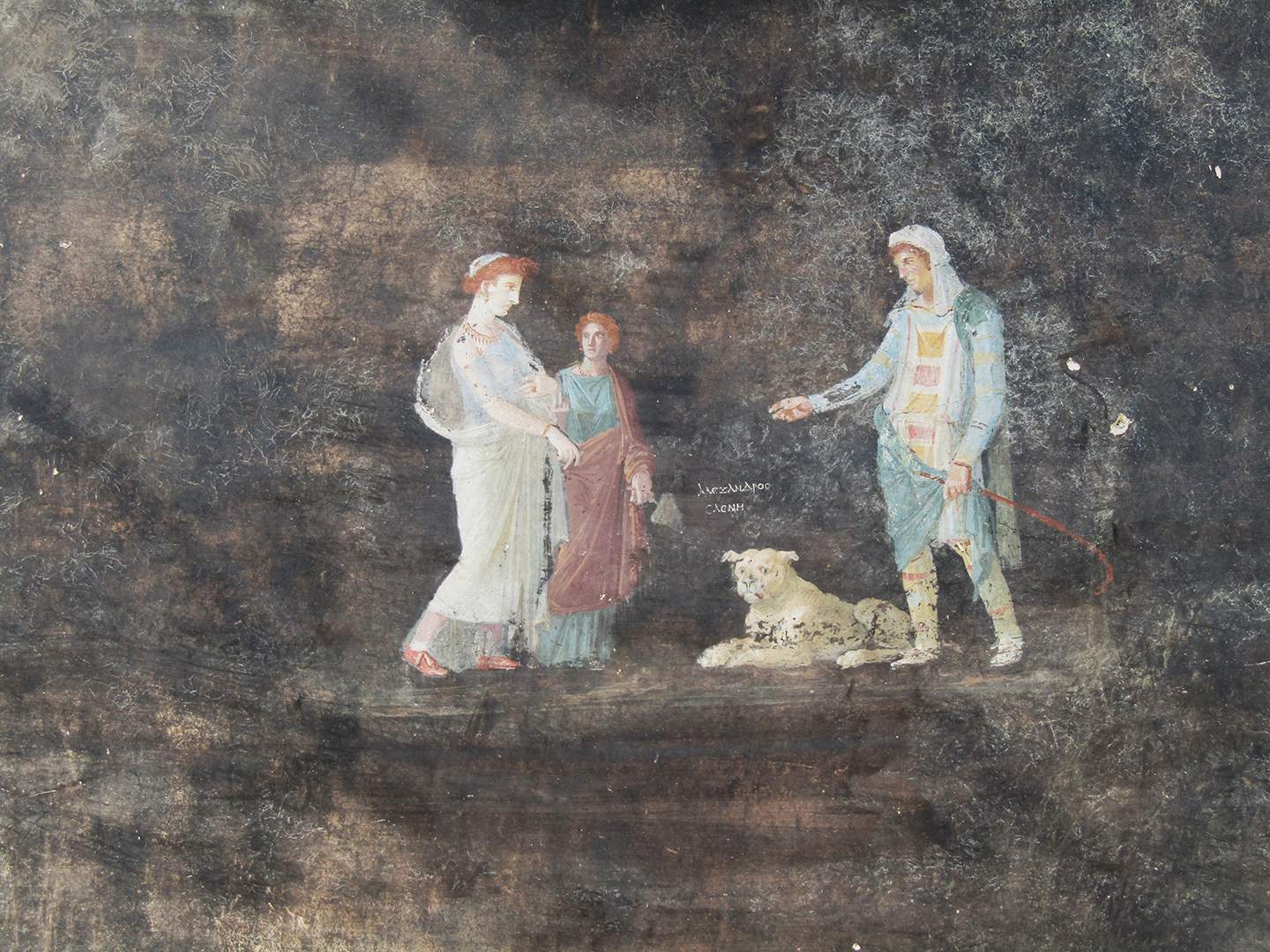A sumptuous banquet hall, with elegant walls painted black and decorated with mythological motifs inspired by the Trojan War, is one of the rooms recently discovered during ongoing excavations in insula 10 of Pompeii’s Regio IX, now visible in all its splendor.
This refined room was intended for convivial gatherings, with banquets and conversations, evidence of the luxurious standard of living at the time, evidenced by the grandeur of the space, the presence of frescoes and mosaics of the III style, the high artistic quality of the paintings and the choice of subjects.
The predominant theme seems to be heroism, with depictions of heroes and gods linked to the Trojan War, along with the concept of destiny and the often elusive possibility of changing one’s future.
In addition to Helen and Paris, referred to in a Greek inscription as “Alexandros,” the hall also features the figure of Cassandra, daughter of Priam, alongside Apollo. In Greek mythology, Cassandra was known for her gift of foresight and the tragic fate that prevented her from influencing the future. Despite her ability to see beyond the present, no one believed her words because of a curse inflicted on her by Apollo for not accepting her courtships. This fate led her to be unable to avoid the tragic events of the Trojan War, which she predicted. After being raped during the fall of Troy, she ended up a slave of Agamemnon in Mycenae.
The frequent presence of mythological figures in the paintings of the entertainment rooms of Roman homes had the social purpose of entertaining guests and diners, offering food for conversation and reflection on life and existence.
The hall, with dimensions of about 15 meters long by 6 meters wide, opens onto a courtyard that appears to serve as a service passage, open to the air, with a long, undecorated staircase leading to the second floor.
A vast accumulation of construction material was found under the arches of the staircase. Someone drew in charcoal on the rough walls of the arches of the great staircase two pairs of gladiators and a large stylized phallus.
The excavation activity in insula 10 of Regio IX is part of a larger project to secure the perimeter front between the excavated and unexcavated area, as well as to improve the hydrogeological structure, with the aim of ensuring more effective and sustainable protection of Pompeii’s vast heritage, which includes more than 13,000 rooms in 1070 dwelling units, as well as public and sacred spaces.
So far, excavation in the area has uncovered two interconnected dwellings, one with a bakery and one fullonica (laundry), which faced Nola Street and whose facades had already been discovered in the late 19th century. Behind these two houses, sumptuous frescoed living rooms, also subject to major renovations at the time of the eruption, are emerging during this phase of excavation.
“Pompeii is truly a treasure chest that never ceases to surprise and amaze us because, every time we excavate, we find something beautiful and significant. We believe in this worldwide unicum that Pompeii represents, and that is why in the budget law we funded new excavations. We need to move forward in the protection of this important site but also in its enhancement,” says Culture Minister Gennaro Sangiuliano.
“The excavation in Regio IX, planned as part of the Great Pompeii Project and carried out under the direction of Zuchtriegel, is a demonstration of how a well-done excavation in the Vesuvian city can continue to increase knowledge of one of the most important places that has come down to us from antiquity. New and unpublished paintings, new data on the huge construction site that was Pompeii at the time of the eruption, new discoveries about the economy and forms of production. An extraordinary harvest of data that is changing the hitherto codified image of the ancient city. I applaud the entire interdisciplinary team that is carrying out the research with passion and professionalism,” says Museums Director General Massimo Osanna.
“The walls were black to prevent the smoke from the lamps on the walls from being seen. People used to gather here to feast after dark, the flickering light of the oil lamps made the images seem to move, especially after a few glasses of good Campanian wine,” stresses Pompeii Archaeological Park Director Gabriel Zuchtriegel. “The mythical couples were cues to talk about the past and life, only seemingly of a merely amorous nature. In reality, they speak of the relationship between the individual and destiny: Cassandra who can see the future but no one believes her; Apollo who sides with the Trojans against the Greek invaders, but though he is a God he cannot ensure victory; Helen and Paris who with their politically incorrect love are the cause of the war, or perhaps just a pretext, who knows. Today, Helen and Paris are all of us: every day we can choose whether to care only about our intimate life or to investigate how this life of ours is intertwined with the big story, thinking for example, in addition to wars and politics, about the environment, but also about the human climate we are creating in our society, communicating with others live and on social media.”
 |
| Pompeii, a frescoed ballroom discovered |
Warning: the translation into English of the original Italian article was created using automatic tools. We undertake to review all articles, but we do not guarantee the total absence of inaccuracies in the translation due to the program. You can find the original by clicking on the ITA button. If you find any mistake,please contact us.